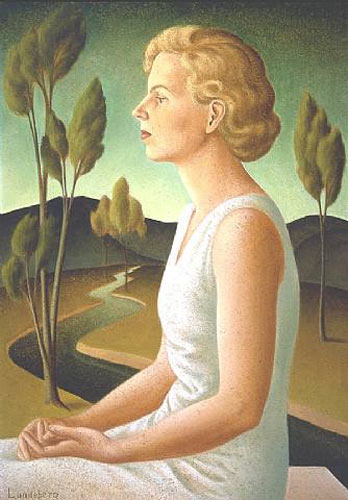
Witness in this exhibition the growing interplay between Lorser Feitelson and Helen Lundeberg‘s artistic production - first as teacher (he) and student (she), then joined in marriage in 1934. Their union laid the foundations for Post-Surrealism and Southern California Hard Edge painting. Born in New York, Feitelson’s initial grounding in European modernism is on display in his dark, internalized “Figure (Kinetic Organization)” (1919-20). In sharp contrast, the earliest exhibited work by Lundeberg, an engaging “Portrait of Inez” (1933) already exhibits the painter’s extraordinary ability to employ color and form in the establishment of mood and exploration of space. Feitelson’s “Prometheus” (1949) is heavy, rough, and out of place color wise with other works in the room. It carries the germ of curved shapes that will emerge more and more frequently in future works by both artists.
Feitelson, prone to the use of dramatic primary color combinations, surprises us with a burst of pink in “Untitled” (1962). The lush hue seems more at home when supported by subtle transitions of light and color in Lundeberg’s “Red Pears” (1987). Feitelson’s command of shiny and dull surfaces in “Magical Space Forms” and Lundeberg’s “Forms in Space” sing a duet of biomorphic, teardrop shapes, almost, but never actually touching. While Feitelson’s reputation was established decades prior in museum shows limited exclusively to male artists, Lundeberg steadily gained recognition for her realization that surreality, visual anxiety and splendor have their roots in the physical and social world. Her sensitivity to color anticipated further investigations by the Light and Space artists so intrinsic to the evolution of Southern California art of the late twentieth century.
Published courtesy of ArtSceneCal ©2011
